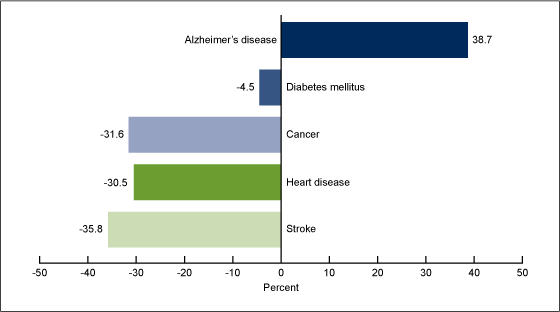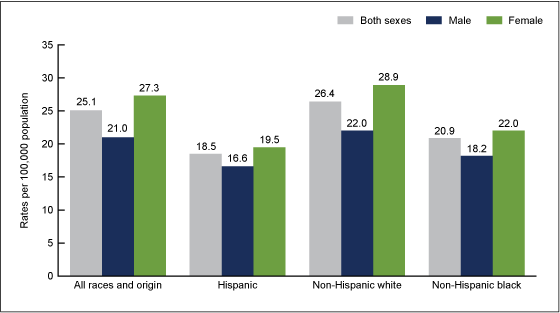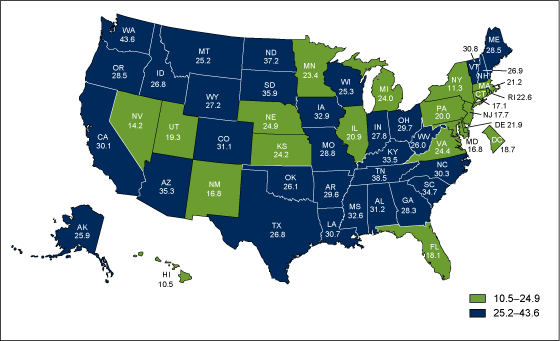Mortality From Alzheimer's Disease in the United States: Data for 2000 and 2010
NCHS Data Brief No. 116, March 2013
On This Page
- Key findings
- Alzheimer's disease mortality increased compared with selected major causes of death.
- Alzheimer's disease mortality risk increased most for the oldest age groups.
- Alzheimer's disease mortality is highest for the non-Hispanic white population and for women.
- Alzheimer's disease death rates varied widely across the states.
- Summary
- Definitions
- Data source and methods
- About the author
- References
- Suggested citation
PDF Version (680 KB)
Betzaida Tejada-Vera, M.S.
Key findings
Data from the National Vital Statistics System
- The age-adjusted death rate from Alzheimer's disease increased by 39 percent from 2000 through 2010 in the United States.
- Alzheimer's disease is the sixth leading cause of death in the United States and is the fifth leading cause among people aged 65 years and over. People aged 85 years and over have a 5.4 times greater risk of dying from Alzheimer's disease than people aged 75–84 years.
- The risk of dying from Alzheimer's disease is 26 percent higher among the non-Hispanic white population than among the non-Hispanic black population, whereas the Hispanic population has a 30 percent lower risk than the non-Hispanic white population.
- In 2010, among all states and the District of Columbia, 31 states showed death rates from Alzheimer's disease that were above the national rate (25.1).
In 2010, Alzheimer's disease was the underlying cause for a total of 83,494 deaths and was classified as a contributing cause for an additional 26,488 deaths (1). Mortality from Alzheimer's disease has steadily increased during the last 30 years. Alzheimer's disease is the sixth leading cause of death in the United States and the fifth leading cause for people aged 65 years and over (1). An estimated 5.4 million persons in the United States have Alzheimer's disease (2). The cost of health care for people with Alzheimer's disease and other dementia was estimated to be 200 billion dollars in 2012, including 140 billion dollars in costs to Medicare and Medicaid and is expected to reach 1.1 trillion dollars in 2050 (2).
Alzheimer's disease mortality varies by age, sex, race, Hispanic origin, and geographic area. This report presents mortality data on Alzheimer's disease based on data from the National Vital Statistics System from 2000 through 2010, the most recent year for which detailed data are available.
Keywords: dementia, National Vital Statistics System, death rate, aging
Alzheimer's disease mortality increased compared with selected major causes of death.
Figure 1. Percent change in age-adjusted death rates for selected causes of death: United States, 2000 and 2010
SOURCE: National Vital Statistics System, Mortality.
Compared with other selected causes, Alzheimer's disease has been on the rise since the last decade. For 2000 and 2010, the age-adjusted death rate for Alzheimer's disease increased by 39 percent, whereas death rates for other major causes of death decreased (Figure 1). The largest decreases in death rates among selected major causes of death were observed for Stroke (36 percent), Heart disease (31 percent), and Cancer (32 percent).
Alzheimer's disease mortality risk increased most for the oldest age groups.
The risk of dying from Alzheimer's disease increases significantly with age. In 2010, the population aged 85 years and over was 50 times more likely to die from Alzheimer's disease than the age group 65–74 years. Similarly, persons aged 85 years and over were 5 times more likely to die from Alzheimer's disease than the age group 75–84 years (Figure 2).
For 2000 and 2010, age-specific death rates from Alzheimer's disease for the age group 65–74 years increased 6 percent, for the age group 75–84 years the increase was 32 percent, and for the age group 85 years and over the increase was 48 percent.
Figure 2. Age-adjusted death rates for Alzheimer's disease: United States, 2000 and 2010
SOURCE: National Vital Statistics System, Mortality.
Alzheimer's disease mortality is highest for the non-Hispanic white population and for women.
In 2010, the age-adjusted death rate for Alzheimer's disease was 26 percent higher for the non-Hispanic white population than for the non-Hispanic black population. Similarly, the age-adjusted death rate is 43 percent higher for the non-Hispanic white population than for the Hispanic origin population (Figure 3).
Overall, women had a 30 percent higher risk of dying (27.3 per 100,000 population) from Alzheimer's disease than men (21.0). Non-Hispanic white women had the highest mortality rate from Alzheimer's disease, followed by non-Hispanic black women. Likewise, among men, the highest age-adjusted death rates were for non-Hispanic white men (22.0), followed by non–Hispanic black men (18.2). Hispanic men (16.6) and Hispanic women (19.5) had the lowest death rates for Alzheimer's disease.
Figure 3. Age-adjusted death rates for Alzheimer’s disease, by Hispanic origin, race for non-Hispanic population, and sex: United States, 2010
NOTE: Death rates for Hispanic origin should be interpreted with caution because of inconsistencies in reporting Hispanic origin on the death certificate as compared with censuses, surveys, and birth certificates.
SOURCE: National Vital Statistics System, Mortality.
Alzheimer's disease death rates varied widely across the states.
The age-adjusted death rates for Alzheimer's disease do not show a clear geographic pattern across the states (Figure 4). In 2010, the states with the highest age-adjusted death rates were Washington (43.6), Tennessee (38.5), and North Dakota (37.2). The states with the lowest age-adjusted death rates were Hawaii (10.5), New York (11.3), and Nevada (14.2). Overall, 31 states had rates above the U.S. rate (25.1), whereas 19 states and the District of Columbia had rates lower than the U.S. rate.
Figure 4. Age-adjusted death rates for Alzheimer’s disease for the United States and each state, 2010
NOTE: The national rate is 25.1 deaths per 100,000 population.
SOURCE: National Vital Statistics System, Mortality.
Summary
Mortality from Alzheimer's disease in 2010 continued to increase among most groups described by sex, age, and race and Hispanic origin (1). An estimated 84,691 deaths in 2011 were from Alzheimer's disease according to preliminary data (3). Alzheimer's disease is currently the sixth leading cause of death in the United States. The overall age-adjusted death rate rose 39 percent from 18.1 in 2000 to 25.1 in 2010. The death rate for Alzheimer's disease is higher for women than for men and higher for the non-Hispanic white population than for the non-Hispanic black population and the Hispanic origin population. Although continuing increases in Alzheimer's disease mortality were observed for all discussed groups, differences in Alzheimer's mortality across ethnic and racial groups are notable (1).
Definitions
Alzheimer's disease: The most common form of dementia that causes decline in cognitive abilities and gradually worsens (4).
Cause-of-death classification: Medical information—including injury diagnoses and external causes of injury—entered on death certificates filed in the United States, classified and coded in accordance with the International Statistical Classification of Diseases and Related Health Problems, Tenth Revision (ICD–10) (5).
Death rates: Based on population estimates consistent with the April 1, 2010, census. Death rates for previous years—whenever shown or discussed in this report—are also based on populations revised to be consistent with the 2010 census. These population estimates are available on the National Center for Health Statistics (NCHS) website at U.S. Census Populations With Bridged Race Categories.
Age-adjusted death rates: Based on the 2000 U.S. standard population, these rates are useful when comparing different populations because they remove the potential bias that can occur when the populations being compared have different age structures. NCHS uses the "direct" method of standardization. See the Technical Notes of "Deaths: Final Data for 2009" (6) for more discussion.
Underlying cause of death: Defined by the World Health Organization as ''the disease or injury which initiated the train of events leading directly to death, or the circumstances of the accident or violence which produced the fatal injury'' (5). The underlying cause is selected from the conditions entered by the medical certifier in the cause-of-death section of the death certificate.
Leading causes of death: Sorted into rank order according to the number of deaths beginning with the largest number. See the Technical Notes of "Deaths: Final Data for 2009" (6) for more detail.
Data source and methods
The figures shown in this report reflect information that is collected on death certificates filed in each of the independent registration areas throughout the United States. Data are from the public-use multiple cause-of-death files from the National Vital Statistics System for years 2000–2010 (1). Death rates are based on the population estimates consistent with the April 2010 census (7). The preliminary mortality data for 2011 are based on a large portion (98.9 percent of the demographic file and 97.3 percent of the medical file) of the statistical records that are continuously received by NCHS from states' vital registration system. Figures by race and ethnic group are based on the race and ethnic group reported for the decedent. See the Technical Notes of "Deaths: Final Data for 2009" (6) for more discussion of the data.
About the author
Betzaida Tejada-Vera is a statistician with the Centers for Disease Control and Prevention's National Center for Health Statistics, Division of Vital Statistics, Mortality Statistics Branch.
References
- National Center for Health Statistics. National Vital Statistics System. Multiple cause-of-death files.
- Alzheimer's Association. Alzheimer's disease facts and figures, Alzheimer's & dementia [PDF - 1.2 MB] Vol 8, Issue 2. 2012.
- Hoyert DL, Xu JQ. Deaths: Preliminary data for 2011 [PDF - 891 KB]. National vital statistics reports; vol 61 no 6. Hyattsville, MD: National Center for Health Statistics. 2012.
- Alzheimer's Disease Education and Referral Center National Institute on Aging. Accessed on Dec 3, 2012.
- World Health Organization. International statistical classification of diseases and related health problems, tenth revision, 2nd edition. Geneva, Switzerland. 2004.
- Kochanek KD, Xu JQ, Murphy SL, Miniño AM, Kung H. Deaths: Final data for 2009 [PDF - 3.1 MB]. National vital statistics reports; vol 60 no 3. Hyattsville, MD: National Center for Health Statistics. 2011.
- National Center for Health Statistics. Bridged-race population estimates. April 1, 2010.
Suggested citation
Tejada-Vera B. Mortality from Alzheimer's disease in the United States: Data for 2000 and 2010. NCHS data brief, no 116. Hyattsville, MD: National Center for Health Statistics. 2013.
Copyright information
All material appearing in this report is in the public domain and may be reproduced or copied without permission; citation as to source, however, is appreciated.
National Center for Health Statistics
Edward J. Sondik, Ph.D., Director
Jennifer H. Madans, Ph.D., Associate Director for Science
Division of Vital Statistics
Charles J. Rothwell, M.S., Director
- Page last reviewed: November 6, 2015
- Page last updated: March 19, 2013
- Content source:


 ShareCompartir
ShareCompartir



